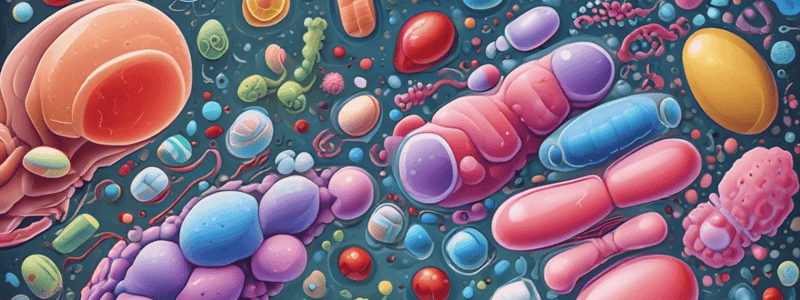Podcast
Questions and Answers
Which of the following bacteria is susceptible to first-generation cephalosporins?
Which of the following bacteria is susceptible to first-generation cephalosporins?
- E. coli (correct)
- Enterococci
- MRSA
- L. monocytogenes
What is the main difference between true cephalosporins and cephamycins?
What is the main difference between true cephalosporins and cephamycins?
- Their spectrum of activity against gram-negative bacteria
- The fungus they were originally isolated from (correct)
- Their activity against anaerobes, intracellular bacteria, and spirochetes
- Their ability to bind to PBPs of MRSA and MRSE
Why are first-generation cephalosporins ineffective against MRSA and MRSE?
Why are first-generation cephalosporins ineffective against MRSA and MRSE?
- Because they are incapable of binding to their PBPs (correct)
- Because they are not effective against gram-negative bacteria
- Because they are not effective against anaerobes, intracellular bacteria, and spirochetes
- Because they are not effective against Streptococcus pneumoniae
What is the main limitation of first-generation cephalosporins against gram-negative bacteria?
What is the main limitation of first-generation cephalosporins against gram-negative bacteria?
Which of the following bacteria is not susceptible to first-generation cephalosporins?
Which of the following bacteria is not susceptible to first-generation cephalosporins?
What is the main advantage of second-generation cephalosporins over first-generation cephalosporins?
What is the main advantage of second-generation cephalosporins over first-generation cephalosporins?
What is the activity of true cephalosporins against Gram-positive bacteria?
What is the activity of true cephalosporins against Gram-positive bacteria?
Which of the following is not a Gram-negative bacterium that is susceptible to second-generation cephalosporins?
Which of the following is not a Gram-negative bacterium that is susceptible to second-generation cephalosporins?
What is the anaerobic activity of cefoxitin and cefotetan?
What is the anaerobic activity of cefoxitin and cefotetan?
Which generation of cephalosporins has activity against anaerobic bacteria?
Which generation of cephalosporins has activity against anaerobic bacteria?
What is the activity of cefoxitin and cefotetan against Gram-positive bacteria?
What is the activity of cefoxitin and cefotetan against Gram-positive bacteria?
Which of the following bacteria is susceptible to second-generation cephalosporins?
Which of the following bacteria is susceptible to second-generation cephalosporins?
What is the activity of true cephalosporins against Gram-negative bacteria?
What is the activity of true cephalosporins against Gram-negative bacteria?
Which of the following is a characteristic of second-generation cephalosporins?
Which of the following is a characteristic of second-generation cephalosporins?
What is the difference in activity against aerobic gram-positive bacteria between individual second-generation cephalosporins?
What is the difference in activity against aerobic gram-positive bacteria between individual second-generation cephalosporins?
What is the strength of the second-generation cephalosporin agents?
What is the strength of the second-generation cephalosporin agents?
Which bacteria are the true cephalosporins also active against?
Which bacteria are the true cephalosporins also active against?
What is the consequence of the additional methoxy group on the β-lactam ring of the cephamycins?
What is the consequence of the additional methoxy group on the β-lactam ring of the cephamycins?
What is the trade-off for the cephamycins' enhanced anaerobic activity?
What is the trade-off for the cephamycins' enhanced anaerobic activity?
Why are agents like cefotetan and cefoxitin categorized as cephalosporins?
Why are agents like cefotetan and cefoxitin categorized as cephalosporins?
What is the primary limitation of first-generation cephalosporins against Staphylococcus aureus?
What is the primary limitation of first-generation cephalosporins against Staphylococcus aureus?
Which of the following bacteria is susceptible to first-generation cephalosporins?
Which of the following bacteria is susceptible to first-generation cephalosporins?
What is the difference between true cephalosporins and cephamycins?
What is the difference between true cephalosporins and cephamycins?
What is the main advantage of second-generation cephalosporins over first-generation cephalosporins?
What is the main advantage of second-generation cephalosporins over first-generation cephalosporins?
What is the primary activity of cefoxitin and cefotetan?
What is the primary activity of cefoxitin and cefotetan?
What is the primary advantage of cephamycins over true cephalosporins?
What is the primary advantage of cephamycins over true cephalosporins?
What is a common characteristic of second-generation cephalosporins?
What is a common characteristic of second-generation cephalosporins?
Which of the following bacteria is not affected by the additional methoxy group on the β-lactam ring of the cephamycins?
Which of the following bacteria is not affected by the additional methoxy group on the β-lactam ring of the cephamycins?
What is the main difference in activity between true cephalosporins and cephamycins against aerobic gram-positive bacteria?
What is the main difference in activity between true cephalosporins and cephamycins against aerobic gram-positive bacteria?
Which of the following is a characteristic of the cephamycins?
Which of the following is a characteristic of the cephamycins?
Why are agents like cefotetan and cefoxitin categorized as cephalosporins?
Why are agents like cefotetan and cefoxitin categorized as cephalosporins?
What is the consequence of the additional methoxy group on the β-lactam ring of the cephamycins?
What is the consequence of the additional methoxy group on the β-lactam ring of the cephamycins?
What is the key difference in the nucleus of cephalosporins compared to penicillin?
What is the key difference in the nucleus of cephalosporins compared to penicillin?
What is one advantage of the cephalosporin core over the penicillin core?
What is one advantage of the cephalosporin core over the penicillin core?
What is the site of attachment for cephalosporins that exerts their antibiotic effect?
What is the site of attachment for cephalosporins that exerts their antibiotic effect?
What are the two sites on the cephalosporin core that can be modified?
What are the two sites on the cephalosporin core that can be modified?
What is the ring structure fused to the -lactam ring in cephalosporins?
What is the ring structure fused to the -lactam ring in cephalosporins?
What is the mechanism of action of cephalosporins?
What is the mechanism of action of cephalosporins?
What is a key advantage of cephalosporins over penicillin?
What is a key advantage of cephalosporins over penicillin?
What is the structural feature of cephalosporins that allows them to be more resistant to -lactamases?
What is the structural feature of cephalosporins that allows them to be more resistant to -lactamases?
Flashcards are hidden until you start studying
Study Notes
First-Generation Cephalosporins
- Effective against infections caused by many strains of Staphylococcus aureus
- Ineffective against MRSA, MRSE, and highly penicillin-resistant Streptococcus pneumoniae
- Limited activity against aerobic and facultative gram-negative bacteria
- Susceptible to some strains of E. coli, Klebsiella pneumoniae, and Proteus mirabilis
- Moderate to poor activity against anaerobes, intracellular bacteria, and spirochetes
Second-Generation Cephalosporins
- Divided into two groups: true cephalosporins (e.g. cefuroxime) and cephamycins (e.g. cefotetan and cefoxitin)
- Cephamycins are derivatives of a parent compound from Streptomyces lactamdurans
- True cephalosporins have activity equivalent to first-generation agents against gram-positive bacteria
- Cephamycins have little activity against gram-positive bacteria
- Active against gram-negative bacteria, including Escherichia coli, Klebsiella pneumoniae, Proteus mirabilis, Haemophilus influenzae, and Neisseria spp.
- Cefoxitin and cefotetan have moderate anaerobic activity
Cephamycins
- Include cefotetan and cefoxitin
- Have relatively limited activity against aerobic gram-positive bacteria
- Have enhanced stability to the β-lactamases of some anaerobes, such as B. fragilis
- Diminished activity against staphylococci and streptococci due to decreased affinity for the PBPs of these bacteria
Second-Generation Cephalosporins
- Not actually cephalosporins, but chemically and pharmacologically similar
- Differ in activity against aerobic gram-positive bacteria
- True cephalosporins are as active against aerobic gram-positive cocci as first-generation agents
- Cephamycins (cefotetan and cefoxitin) have relatively limited activity against these bacteria
Activity Against Bacteria
- Second-generation agents have increased activity against:
- Aerobic and facultative gram-negative bacteria
- E. coli, K. pneumoniae, and P. mirabilis
- Neisseria spp.
- H. influenzae (including β-lactamase-producing strains)
- Cephamycins have enhanced stability against β-lactamases of some anaerobes (e.g., B. fragilis)
- True cephalosporins are more active against H. influenzae and Neisseria spp.
Comparison with First-Generation Cephalosporins
- First-generation cephalosporins have limited activity against:
- Aerobic and facultative gram-negative bacteria
- Anaerobes, intracellular bacteria, and spirochetes
- First-generation cephalosporins are ineffective against:
- MRSA and MRSE
- Many highly penicillin-resistant S. pneumoniae
- L. monocytogenes and enterococci
Structure and Mechanism of Action
- Cephalosporin nucleus is 7-aminocephalosporanic acid
- β-Lactam ring is fused to a six-member dihydrothiazine ring
- Cephalosporin core has two major advantages over penicillin core:
- Intrinsic resistance to cleavage by β-lactamases
- Two sites (R1 and R2) for modification
- Cephalosporins exert their effects by attaching to and inhibiting PBPs, preventing peptidoglycan synthesis
Studying That Suits You
Use AI to generate personalized quizzes and flashcards to suit your learning preferences.




